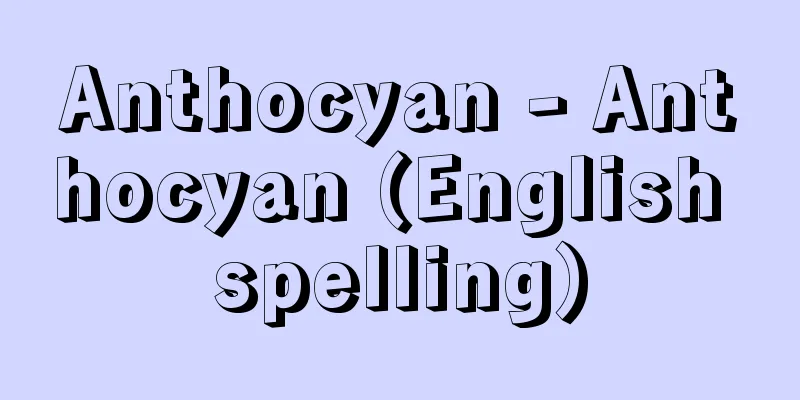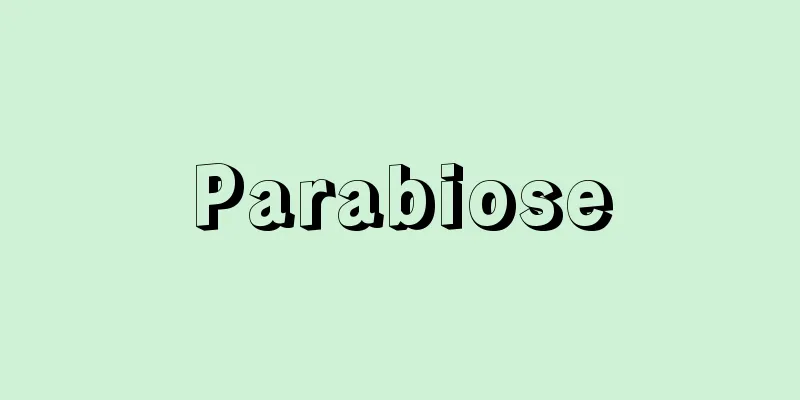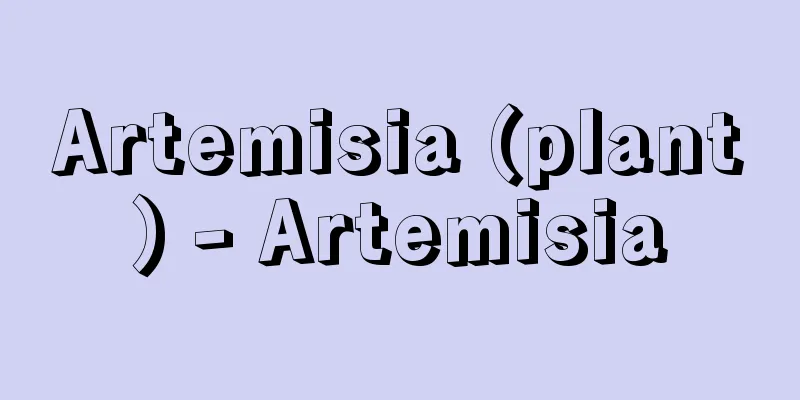Anthocyan - Anthocyan (English spelling)

|
A group of plant pigments, referring to the pigments found in flowers, leaves, fruits, etc. that are red, blue, dark purple, etc. Named from the Greek words anthos (flower) and cyanos (blue), it is also called anthocyanin. Its basic structure is a carbon skeleton with two benzene rings connected by three carbons, and it is included in the flavonoid pigment group. Anthocyanidins, the main pigment body (aglycone), and anthocyanins, which are pigment glycosides formed by binding sugar to anthocyanin, are collectively called anthocyanins. They exist in the form of glycosides in solution in the vacuoles of plant cells, but if present in large quantities, they may precipitate as crystals or lumps. They dissolve in water and turn red in acidic conditions, purple when neutralized, and blue when slightly alkaline. They have indicator properties, such as returning to red when acidic, so they can be easily distinguished from other carotenoid and betalain pigments that have similar colors. There are more than 20 known types of anthocyanidins, but because the types and numbers of sugars that bind to them vary widely, there are an extremely large number of types of anthocyanins. Even the same pigment glycoside can have a wide variety of colors when contained in plants. At first, the cause of this change in color was thought to be the hydrogen ion potential (pH) in the vacuole, but since the pH in the vacuole is often weakly acidic, this alone cannot explain the blue color of flowers except in special cases. Research on anthocyanins in blue dayflowers and blue cornflowers has revealed that anthocyanins form complex salts with metals such as aluminum and magnesium in the vacuole, and further form complexes with other substances such as flavones, thereby expressing the unique color of each flower. The epidermal structure of flowers is also an important factor in the subtle changes in flower color. In flowers, anthocyanins are mainly present only in the epidermal cells, but in autumn leaves, they are mainly produced in the mesophyll cells of the leaves. As temperatures drop in autumn, the chlorophyll in the leaves breaks down rapidly, and instead, the anthocyanin pigment stands out, creating a vibrant autumn color. However, in the autumn leaves of Euonymus japonica and Cryptomeria japonica, and in the young leaves that turn red in early spring, the pigment is localized only in the epidermal cells. Anthocyanidins, which are the main pigments, are broadly classified into three basic types: pelargonidin, cyanidin, and delphinidin. The sugars that bind to them include glucose, galactose, xylose, and rhamnose, and the types and numbers vary. Ferns are characterized by the distribution of 3-deoxyanthocyanidins. Anthocyanins are extremely unstable substances and fade easily when pressed or cut, so they must be stored in an airtight container or protected from light. In the body, anthocyanins are synthesized from phenylalanine and acetic acid, with the final reaction thought to take place in the vacuole membrane. Various factors are involved in the production of anthocyanins, and it is influenced by external conditions such as temperature, light, and nitrogen and phosphate deficiencies. The physiological role of anthocyanins is still unclear, but it is said that anthocyanins are temporarily produced in young leaves in early spring because anthocyanins absorb ultraviolet rays and protect the plant from their harmful effects. The autumn coloring of leaves is also thought to be one aspect of aging. [Seiichi Yoshida and Takao Minamikawa] "Secondary Metabolism of Higher Plants" by Yoshida Seiichi and Minamikawa Takao (1978, University of Tokyo Press)" ▽ "Physiology of Plant Metabolism" by Ishikura Shigeyuki (1987, Morikita Publishing)" ▽ "Orchid Biology 2" edited by Joseph Arditi and translated by Ichihashi Shoichi (1991, Seibundo Shinkosha)" ▽ "Biohorti 6: Shoot Primordia and Mass Propagation, Breeding of Pink Flowers" edited by the Agriculture and Horticulture Editorial Department (1991, Seibundo Shinkosha)" ▽ "Overview of Natural Edible Pigments" by Shimizu Takashige and Nakamura Mikio (1993, Korin)" ▽ "Gene Expression in Plants" edited by Nagata Toshiyuki and Uchimiya Hirofumi (1995, Kodansha)" ▽ "Introduction to Plant Molecular Physiology" by Yokota Akiho (1999, Academic Press Center)" ▽ "Anthocyanins: Food Color and Health" edited by Oba Riichiro et al. (2000, Kenpakusha) " "Health Studies from the Earth: Regional Specialties and the Prevention of Lifestyle-Related Diseases" edited by the Japan Specialty Agricultural Products Association (2001, Agriculture and Forestry Statistics Association) " "Food and Color" by Katayama Osamu and Tajima Makoto (2003, Korin)" [References] | | | | | | | | | | | | | | | | | |Source: Shogakukan Encyclopedia Nipponica About Encyclopedia Nipponica Information | Legend |
|
植物色素の一群で、赤、青、暗紫色などを呈する花や葉、果実などの色素のこと。ギリシア語のanthos(花)+cyanos(青い)の意味から命名され、花青素(かせいそ)ともよばれた。基本構造として2個のベンゼン環が3個の炭素で結ばれた炭素骨格をもち、フラボノイド色素群に含まれる。色素の本体(アグリコン)であるアントシアニジンと、これに糖が結合した色素配糖体であるアントシアニンの両方をあわせてアントシアンとよんでいる。植物細胞の液胞内に配糖体の形で溶けた状態で存在するが、多量に含まれると結晶、あるいは塊となって析出することもある。水に溶けて、酸性で赤色となり、中和すると紫色に、微アルカリ性で青色に変わる。これをまた酸性にすると赤色に戻るなど指示薬的な性質をもっているので、他の同じような色を呈するカロチノイド色素やベタレイン色素と容易に区別することができる。 アントシアニジンは20余種が知られているが、これらに結合する糖の種類と数が千差万別なため、アントシアニンの種類はきわめて多い。また同じ色素配糖体でも、植物に含まれているときはかなり色調が違い、多様な色を示す。このような色調の変化の原因として、初めは液胞内の水素イオン指数(pH)によると考えられたが、液胞内のpHは多くの場合、弱酸性であることから、特殊の場合を除いては花の青色についてはこれだけでは説明がつかない。ツユクサの青色花やヤグルマギクの青色花などのアントシアンの研究から、液胞内ではアントシアニンはアルミニウム、マグネシウムなどの金属と錯塩を形成し、さらにフラボン類などの他の物質と複合体をつくったりして、それぞれの花に特有の色調を発現していることがわかってきた。また花の表皮構造も花色に微妙な色彩の変化をもたらす重要な原因となっている。アントシアンは花では主として表皮細胞にだけ存在するが、秋の紅葉の場合には葉の葉肉細胞に主として生成する。秋になって気温が低下するとともに葉のクロロフィルが急速に分解し、それにかわってアントシアニン色素が目だつようになり、鮮やかな紅葉をつくり出す。しかし、ニシキギやツリバナの紅葉や、春先に若葉が紅色になる場合は表皮細胞にだけ色素が局在している。 色素の本体であるアントシアニジンは、ペラルゴニジン、シアニジン、デルフィニジンの3種の基本形に大別される。これに結合する糖にはグルコース、ガラクトース、キシロース、ラムノースなどがあり、種類も数もさまざまである。シダ植物には3-デオキシアントシアニジンが分布しているのが特徴である。 アントシアンはきわめて不安定な物質で、押し花や切り花にすると容易に退色してしまうので、気密にしたり光を遮るなどして保存する。アントシアンは生体内ではフェニルアラニンと酢酸から合成されるが、最終段階の反応は液胞膜で行われると考えられている。アントシアンの生成にはいろいろの要因が関係していて、温度、光、窒素やリン酸の欠乏などの外部条件によって左右される。アントシアンの生理的役割についてはまだ明らかでないが、春先の若葉に一時的にアントシアンが生成するのは、アントシアンが紫外線を吸収して、その害から植物を保護するためであるといわれる。また秋の紅葉は老化の一つの側面と考えられる。 [吉田精一・南川隆雄] 『吉田精一・南川隆雄著『高等植物の二次代謝』(1978・東京大学出版会)』▽『石倉成行著『植物代謝生理学』(1987・森北出版)』▽『ジョセフ・アーディティ編著、市橋正一編訳『ランの生物学2』(1991・誠文堂新光社)』▽『農耕と園芸編集部編『バイオホルティ6 苗条原基と大量増殖 桃色花の育種』(1991・誠文堂新光社)』▽『清水孝重・中村幹雄著『概説 食用天然色素』(1993・光琳)』▽『長田敏行・内宮博文編『植物の遺伝子発現』(1995・講談社)』▽『横田明穂著『植物分子生理学入門』(1999・学会出版センター)』▽『大庭理一郎ほか編著『アントシアニン――食品の色と健康』(2000・建帛社)』▽『篠原和毅・近藤和雄監修、日本特産農産物協会編『大地からの健康学――地域特産と生活習慣病予防』(2001・農林統計協会)』▽『片山脩・田島真著『食品と色』(2003・光琳)』 [参照項目] | | | | | | | | | | | | | | | | | | | | | |出典 小学館 日本大百科全書(ニッポニカ)日本大百科全書(ニッポニカ)について 情報 | 凡例 |
>>: Antokol'skiy (English spelling) Pavel Grigor'evich Antokol'skiy
Recommend
Ako Misaki
A scenic spot in Ako city, on the southwestern ti...
Tatsuta
A district of Ikaruga Town, Ikoma County, in nort...
Pâté - Pâté (English spelling)
A French film company founded in the early days o...
Titanium oxide - Sankachitan (English spelling) titanium oxide
A compound of titanium and oxygen. Three types of...
Goldback fern
...A genus of ornamental fern in the Caprifoliace...
Kanto
[1] (meaning east of the checkpoint) [1] Since the...
Bain, JS (English spelling)
...Based on this foundation, in the 1940s, econom...
Skinned Whale - Kawakujira
〘 noun 〙 The fat part under the skin of a whale. I...
Cagniard de la Tour, C. (English spelling)
...The state of matter at this temperature and pr...
Beaune (English spelling)
A town in the Côte d'Or department in central-...
Red pox - red pox
〘Name〙 = Akamogasa (red smallpox) *Nihon Kiryo - J...
Otway, Thomas
Born: 3 March 1652, Trotton, Sussex [Died] April 1...
Emmanuel, Pierre
[Born] May 3, 1916. Bus Pyrenees, Goose [Died] Sep...
Fargo, WG (English spelling) FargoWG
…A transportation and finance company that played...
Winchester Bushel
…It is the base unit of dry mass, defined as 2150...









